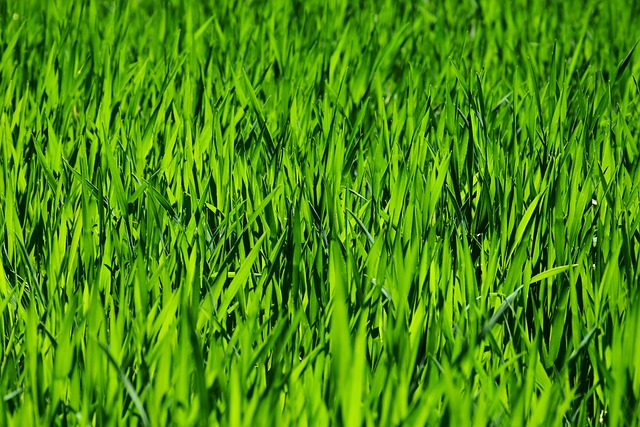Lawn Care and Landscaping are essential for maintaining a healthy, visually appealing lawn, with mulching being a key practice that enhances soil fertility, temperature regulation, and moisture retention, leading to robust grass growth and minimizing weed competition. Mulch also acts as a physical barrier, aiding in weed suppression and conserving soil moisture, which is cost-effective and eco-friendly. Edging, another crucial element, sharpens the lawn's boundaries, promoting better water drainage, preventing disease and pests, and contributing to a manicured appearance. Combining mulching with precise edging not only elevates the lawn's aesthetic but also optimizes resource use and soil health management for a lush, well-defined lawn that remains vibrant throughout the year within the realm of Lawn Care and Landscaping.
Embarking on a journey to cultivate a lush, vibrant lawn involves more than just watering and mowing. The intricacies of mulching and edging play pivotal roles in maintaining a well-manicured and healthy outdoor space. This article delves into ‘Lawn Care and Landscaping’ best practices, beginning with the essentials of mulching which not only retains soil moisture but also suppresses weeds and enhances the visual appeal of your greenery. We then transition to mastering the art of edging, a technique that sharpens the demarcation between your lawn and garden paths or flowerbeds, lending structure and order to your landscape design. Finally, we explore how integrating both mulching and edging into your regular lawn care routine can lead to a comprehensive maintenance strategy that ensures your lawn remains the envy of the neighborhood all year round.
- The Role of Mulching in Enhancing Lawn Health and Aesthetics
- Mastering the Art of Edging for a Defined and Manicured Lawn Border
- Integrating Mulching with Edging for Comprehensive Lawn Care and Landscaping Maintenance Strategies
The Role of Mulching in Enhancing Lawn Health and Aesthetics

Mulching plays a pivotal role in maintaining the health and enhancing the aesthetics of lawns, making it an integral component of effective lawn care and landscaping practices. When organic mulch is applied to soil surfaces, it decomposes over time, enriching the lawn’s soil with nutrients that promote grass growth. This process not only feeds the lawn but also helps to regulate soil temperature and moisture retention, providing a more hospitable environment for grass roots to thrive. Additionally, mulch acts as a barrier between the grass and harmful weeds, reducing competition for sunlight, water, and nutrients. The result is a lush, vibrant lawn free of unsightly weeds and with a consistent, uniform appearance that is highly sought after in residential and commercial landscaping. Furthermore, the application of mulch can significantly reduce the need for frequent watering by conserving soil moisture, which is both economical and environmentally friendly. Landscapers often utilize grass clippings, leaves, or specially designed rubber mulches to achieve these benefits, each offering different advantages depending on the specific needs and preferences of the lawn care regimen. By incorporating mulching into a comprehensive lawn care and landscaping strategy, homeowners and professionals alike can enhance the visual appeal and health of their lawns, creating an inviting outdoor space that withstands the challenges of various environmental conditions.
Mastering the Art of Edging for a Defined and Manicured Lawn Border

Engaging in meticulous lawn care and landscaping practices can transform your yard into a verdant oasis that stands out in any neighborhood. Mastering the art of edging is a critical component of this process, as it defines the boundary between your lush grass and garden beds or hardscapes. A well-defined edge not only enhances the aesthetic appeal of your lawn but also prevents the encroachment of grass into unwanted areas, which can lead to maintenance challenges. To achieve crisp, clean lines, select the appropriate edging tool for your lawn’s size and terrain. Manual edgers are ideal for smaller spaces, offering precision and control, while gas-powered edgers excel on larger properties where speed and efficiency are paramount. The frequency and precision of edging contribute to a manicured look that elevates the overall curb appeal of your home. Additionally, removing soil and sod from the edge of the lawn not only sharpens the border but also allows for better water drainage, reducing the risk of standing water that could lead to lawn disease or pest infestations. Regular edging, in tandem with proper mowing and fertilization practices, ensures your lawn maintains a neat and orderly appearance year-round, making landscaping an ongoing commitment to both functionality and beauty.
Integrating Mulching with Edging for Comprehensive Lawn Care and Landscaping Maintenance Strategies

Maintaining a healthy and aesthetically pleasing lawn requires a combination of effective lawn care practices, and integrating mulching with edging is a cornerstone of this approach. Mulching serves a dual purpose in lawn maintenance: it retains soil moisture to keep grass hydrated during dry spells and suppresses weed growth by creating a barrier that limits their access to sunlight. When paired with regular edging, the benefits are amplified. Edging defines clear boundaries between your lawn and garden beds or pathways, which not only enhances the visual appeal but also prevents grass encroachment into undesirable areas. This demarcation allows for precise application of mulch, ensuring that it is only where needed, thus reducing waste and increasing efficiency. By combining these practices, homeowners can achieve a well-manicured landscape that not only looks pristine but also promotes a healthy lawn ecosystem. The key to success lies in the consistent application of both edging and mulching as part of an ongoing lawn care and landscaping maintenance strategy. This approach helps to maintain soil health, conserve water, and create a neat and orderly outdoor space that can be enjoyed all year round.
Effective lawn care and landscaping hinge on the nuanced integration of practices like mulching and edging. These techniques not only fortify your lawn’s health but also elevate its visual appeal. By mastering the art of mulching, homeowners can retain soil moisture, suppress weeds, and enrich the soil, leading to a more vibrant and resilient lawn. Pairing this with precise edging creates clean, well-defined boundaries that frame your green space beautifully, signaling attention to detail and care. Combining these strategies as part of a comprehensive lawn care and landscaping maintenance plan ensures a harmonious and manicured landscape that stands out in any neighborhood. Embrace these practices for a lawn that’s both healthy and aesthetically pleasing.
